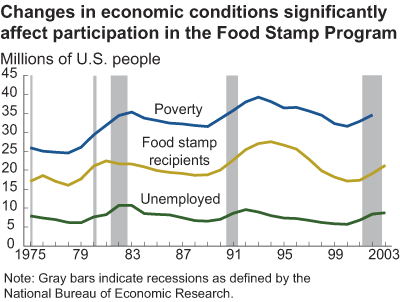Food Stamp Participation Up in 2003
- by Victor Oliveira
- 4/1/2004
Participation in USDA’s Food Stamp Program averaged 21.3 million people per month in fiscal year 2003—an 11-percent increase over the previous year, but below the record 27.5 million participants in fiscal 1994. The weak job market, along with increased efforts by States to improve program access, explains much of the increase in the number of Americans receiving food stamps during fiscal 2003.
Historically, changes in the country’s economic conditions significantly affect participation in the Food Stamp Program. The number of food stamp recipients typically rises during recessionary periods when the number of unemployed and poor people increases, and falls during periods of growth as the number of unemployed and poor people decreases. The labor market was weak during 2003, as the economy remained sluggish. The annual unemployment rate increased from 5.8 percent in 2002 to 6.0 percent in 2003, the highest rate since 1994.
The Food Stamp Program is available to most needy households (subject to certain work and immigration status requirements) with limited incomes and assets. Economic and social conditions affect program participation and expenditure levels through their influence on the size of the eligible population, the rate of participation among eligible people, and the level of benefits provided. Rising food stamp participation is a continuation of a longer term trend: between August 2000 and September 2003, participation in the Food Stamp Program increased in all but 5 of the 38 months. Expenditures for the Food Stamp Program totaled $23.7 billion, unadjusted for inflation, in fiscal 2003 (October 1, 2002, to September 30, 2003)—a 15-percent increase over the previous fiscal year. This dramatic increase in expenditures was due to both increased numbers of people participating and rising per person benefits. The average benefit per person was $83.91 a month, up from $79.68 a month in fiscal 2002.
About 1 in 5 Americans is served by at least 1 of USDA’s 15 domestic food assistance programs aimed at improving the nutrition, well-being, and food security of needy Americans. Preliminary data from USDA’s Food and Nutrition Service indicate that expenditures for these food assistance programs rose 9 percent in fiscal 2003 and totaled $41.6 billion, exceeding the previous record of $38.1 billion spent on food assistance in fiscal 1996. A recent ERS report looks at participation and spending levels for the Food Stamp Program and the four other major Federal food assistance programs—the National School Lunch Program, the Special Supplemental Nutrition Program for Women, Infants, and Children (WIC), the School Breakfast Program, and the Child and Adult Care Food Program.
This article is drawn from:
- Supplemental Nutrition Assistance Program (SNAP). (n.d.). U.S. Department of Agriculture, Economic Research Service.
- Oliveira, V. (2004). The Food Assistance Landscape, March 2004. U.S. Department of Agriculture, Economic Research Service. FANRR-28-4.


